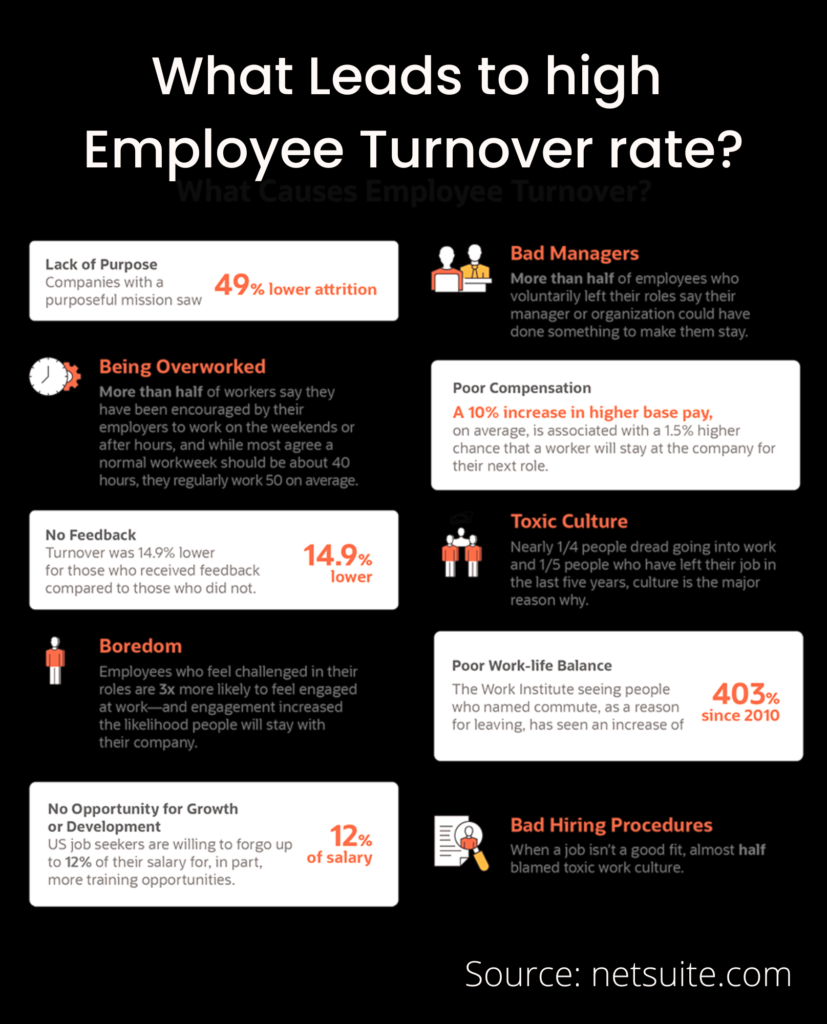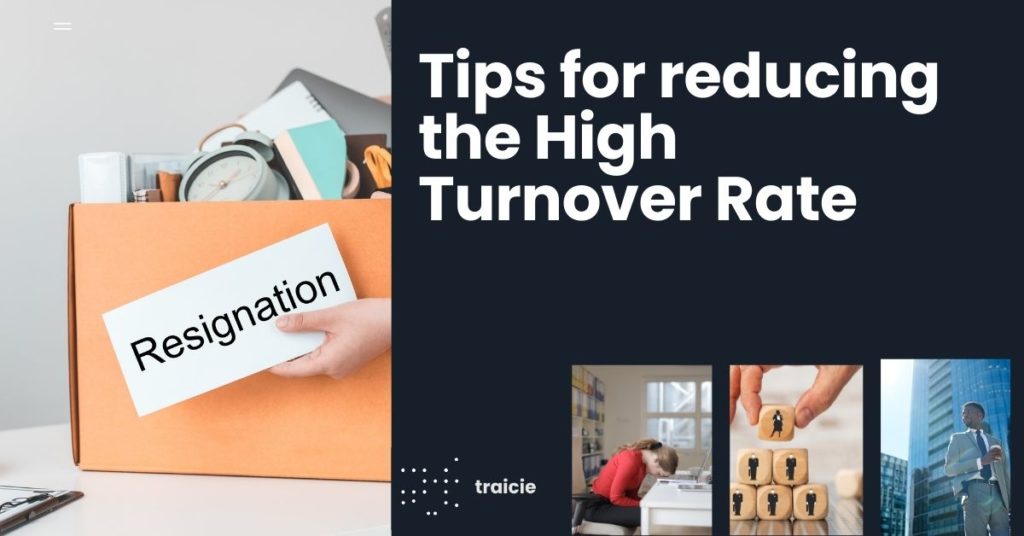Employee turnover rate is a natural metric for any HR Team of Business in any Industry. However, excessive turnover decreases the overall efficiency of the company and comes with a high price tag. The most prosperous businesses cherish their employees and are continually searching for methods to keep their best workers on board.
The frequency of employee departures from a company is measured by staff turnover on a monthly, quarterly and annual basis. The two types of turnover are covered by turnover rates. First, it takes into account individuals who were fired by the organization due to poor performance or inappropriate behavior. Secondly, it takes into account those who left for personal reasons; to pursue new employment or educational possibilities or who retired. Today, rising labor expenses and employee turnover are reducing businesses’ earnings.
What Is a Good Employee Turnover Rate?
Good and poor turnover KPIs vary greatly by industry, function and even region. The average annual turnover in the United States is estimated to be around 20%, with roughly two-thirds of that turnover being voluntary, according to a recent report by analyst firm Mercer. Turnover is likely to trend higher if your company is in the retail, hospitality, or wholesale distribution industries than. According to Mercer, sales (19%), manufacturing and operations (22%) and contact centers/customer service (21%) are the occupational functions with the highest yearly voluntary turnover.
In conclusion, to find trends in your sector, consult industry sources and analysts. Additionally, the U.S. Department of Workers continuously monitors information on job opportunities and labor turnover.
What Leads to High Employee Turnover rate?
Even if the causes of employees leaving are listed in a different order in the several studies that look at turnover each year, they are all consistent. Issues with the company’s culture, perks and compensation plan, career path and training and supervisors are among the causes.

High turnover of employees hurts revenue and, frequently, client pleasure. The main reasons why workers leave their employers are for better pay and benefits, career advancement, a better work-life balance and because their manager is unproductive.
Numerous of these flaws could be categorized as corporate culture issues. This can also encompass a company’s values, career possibilities, pay and perks, work-life balance and the impact of senior leadership. Culture, remuneration and personnel who stay in the same function for an extended period are all indicators of retention.
Why Is It Important to Reduce Employee Turnover?
Employee retention has an impact on business profitability. Delivering business plans and objectives requires a sufficient number of individuals with the appropriate talents. Choosing the appropriate individuals is also becoming more difficult and expensive.
Once the proper individuals have been found, it can be expensive and time-consuming to convince them to join. The hiring process is taking longer and while the majority of firms have raised salaries for paid positions, only 43% have done the same for hourly positions. An additional incentive to decrease turnover is provided by these rising costs.
Personnel morale can also suffer from high employee turnover. If several employees leave the company in a short period of time, workers frequently lose faith in the leadership team. Additionally, it may me neccesary to ask the team members to assume the duties of the departing employee. This increased workload could stress workers out and lower their morale even further.

Specifically
Your business will inevitably encounter a productivity hiccup once a seasoned employee leaves. As mentioned, substitute workers might be called away from their usual duties.
Furthermore, if you do manage to find a successor, that person probably needs weeks or even months of training before they can start producing at the same rate as the departing employee. The corporation must spend more money as a result, which adds up to significant losses.
Losing an experienced employee also means losing knowledge of how your business runs. Any new employee you hire to take the place of someone else will probably start out making more mistakes and end up costing your company more money than the departed worker did.
Last but not least, losing employees that deal directly with clients, such as salespeople and account managers, might increase the likelihood that your business will lose customers. In the event that your employee and the customer established a close working connection, the client can decide to accompany the employee to their new employer, placing you in a precarious situation.
The bond could also be severed, leaving the buyer hanging and severely degrading their whole shopping experience.
Tips for Reducing the Turnover Rate
Make the Job Description Explicit
Unbelievably, lowering employee turnover begins long before their first day on the job. Many companies struggle to adequately define pay and benefit expectations in their job postings; the majority of them don’t even provide a compensation rate.

However, 45% of hiring decision-makers feel that if new recruits had more information during the hiring process, retention rates would increase. Do not be hesitant to disclose the position’s wage range and benefits package upfront.
Employ Great Talent
Choosing the appropriate candidates from the outset can significantly lower staff turnover. Examine potential hires thoroughly through interviews, perform background checks, do reference checks and hold skill evaluations.
Poor hires can be partially attributed to recruiting. Recruiters must be up-up-front and honest with candidates about the culture of the company, rather than just telling them what they think they want to hear. Making sure that recruiting is looking for the appropriate individual from the start is a key component of hiring the right person. According to Jobvite’s research, less than half of the work force thinks that job descriptions accurately reflect actual job duties. Additionally, close to a third have quit their jobs within the first 65 days because they weren’t what they expected.
| >>> You might also interested in: What is a Fractional CEO Chief Executive Officer? [Benefits]
By letting peers who fill that position have an input on the hiring decisions, many firms have seen an increase in their success rate with new workers. Organizations should take the time to learn as much as they can about the candidate.
More tips
Although in-person office visits and opportunities to observe how the applicant responds to and interacts with potential coworkers are excellent, video interviews can occasionally be conducted as well. If at all possible, think about making some positions remote to broaden the pool of potential hires and improve your chances of finding the right person.
Every business has a unique hiring procedure. How do you make sure yours is deliberate and picky? You might be more successful if you choose workers that apart from the necessary talents also share the same cultural and behavioral values as your company.
Asking behavioral interview questions is one method for determining a candidate’s personality and character. Asking someone how they managed an unexpected change in their routine and what they took away from it, for instance, is a good interview question. You can learn a lot about someone’s character from their response.
Spend Money on Enhancing the Onboarding Process
A new employee’s initial exposure to an organization’s culture usually occurs during onboarding. It’s challenging to bounce back from a poor onboarding experience. Negative new hire onboarding experiences double the likelihood that employees may look for new opportunities early on in their employment.
| >>> Read more about: Cognitive Biases in Recruitment Process, How to avoid it?
However, even little process improvements can have a lasting positive impact. After a positive onboarding experience, employees are in fact more likely to be at the company for a number of years. Faster time to productivity is a result of better onboarding. A longer and personal onboarding is especially beneficial.

The most effective onboarding procedures don’t lock workers in a room for eight hours before calling it a day. They facilitate relationships between workers in various areas and coach new hires. They also frequently check in to see how things are going, offering resources and assistance along the way.
Don’t just allow someone fresh in and let them fend for themselves. Make sure they are placed on payroll, receive all of their benefits and are given a tour of the facility.
Make sure they are aware of all customary procedures pertaining to their position. Give them the resources they need to succeed and be explicit about what you want from them throughout their first week, month or quarter. The way a person is perceived at first, determines how they will interact with the company and other people during their employment.
Pay appropriately
To reduce employee turnover rate, companies need to pay appropriately. Making money is the main motivation for employment because everyone requires a source of income to live. And although it may not always be the main or only motivation for your staff, there is no disputing the importance of money.
It’s simple to implement this turnover reduction method. Simple “thank you’s” and notes of appreciation, whether verbal or written, may go a long way in acknowledging the hard work the staff puts in every day. Another excellent approach to rewarding employees is by providing them with new chances.
The manager of an employee has a significant impact here. Employees who felt positively about their manager’s input are much more likely to be engaged, and just a small portion of that group is actively looking for new employment.
Colleague criticism, however, has an equivalent impact. Employee retention at existing companies increases, according to 80% of respondents, when they receive recognition. Peer-to-peer recognition programs are extremely effective, especially when they make use of technology.
Employees who believe they are being underpaid are much more likely to quit than those who believe they are being fairly compensated. Given that, you might need to get inventive with your benefits package if your budget is small.
In order to make up for the reduced salary, you can also create a supportive workplace culture that emphasizes positive reinforcement and encouragement. This will encourage your staff to feel inspired and motivated to advance the business.
Enhanced Agility to Reduce Employee Turnover Rate
If their employer-provided flexible work alternatives, more than 72% of employees would be more devoted to it. Additionally, 81% of workers claimed that being able to telecommute at least occasionally made them more likely to accept a new job offer.
Giving employees more freedom in this area is another strategy to increase retention since employees are becoming more concerned about job flexibility. Flexjobs; an online employment portal reports that, roughly 25% of employees claim they left a job because it did not provide flexible work alternatives. Another 75% indicated they would be more devoted to their employer if flexible work alternatives were available.
| >>> Learn more about: What Is People Analytics? Process, Trends, and Tools Details.
Flexible employment is more than just remote or telework. Flextime, a condensed workweek, part-time scheduling or a job-share arrangement where employees alternate working from the office on different days, are some examples. Although managing remote workers efficiently does present some difficulties, executives should investigate which of these approaches would work best for their company.
Take into account the individual requirements of your staff and when possible and appropriate, provide extra flexibility. Telecommuting, flexible hours, job sharing and on-site daycare are available options.
Encourage employee involvement
We discussed the significance of employee engagement earlier. Making the workplace rewarding, treating workers with respect, offering possibilities for promotion and providing education and training are all ways to boost workplace engagement.
Because increased employee engagement corresponds to reduced turnover rates, it is imperative to constantly monitor this factor. Meeting their social and emotional needs is central concerning the initiatives a lot of firms start to increase participation.

These initiatives showed up in a variety of ways, including fun physical environments, free meals, yearly company outings and more. However, none of those factors had a significant impact on involvement. The relationship an employee has with his or her boss, which Gallup claims accounts for 82% of the variance in employee engagement, is one of several factors that affect employee engagement.
Not all businesses operate in fields that can easily evoke a deep sense of connection to the work. However, those companies may still find out what drives each person and nurture those motivations. Focus groups and employee engagement surveys are great places to start, as long as management considers the findings and takes appropriate action.
We also advise putting in place a structured program for employee engagement. This can involve programs like employee volunteer events that foster camaraderie on your team.
Show Gratitude to Reduce Employee Turnover Rate
Recognizing and rewarding employees for a job well done is another strategy to boost morale among workers and lower attrition. Sending an email to recognize your team or an individual contributor after finishing a challenging project or making a significant sale is a simple way to introduce positive feedback to your firm.
A monthly or quarterly email newsletter that highlights the accomplishments of your team or organization should be sent to your staff. An outstanding employee who goes above and beyond the call of duty to advance the business deserves a thank you card or a small gift.
A little gratitude can go a long way. A less surprising predictor of turnover is ineffective or infrequent performance reviews. Traditional performance reviews, which consist of reviewing an Excel spreadsheet with fixed targets on an annual or biannual basis, aren’t exactly motivating.
Specifically
These traditional reviews might have a negative net effect. According to Gallup, around 69% of employees who felt insulted or unmotivated following a performance review began looking for a new job.
The way to go is to make the performance review a collaborative, dynamic, and ongoing process that strives to strengthen the bond between an employee and a manager rather than erecting barriers between them.
For example, features in human capital management (HCM) or human resources management system (HRMS) or HRIS software reimagine the performance review as a process that unites the manager and employee on goal setting, provides a chance to reflect on the progress, and offers rewards in response to high performance.
| >>> Learn more about: Best HRIS systems for Mid-Sized Companies [Reviews, Rankings]
Managers may quickly and automatically adjust goals in real-time by connecting goals to actionable metrics and evaluating them through performance management dashboards.
Provide possibilities for growth to reduce employee turnover rate
Give your employees a clear idea of their career paths. Show them the potential destinations and routes their profession might take them. Find out what employees want to do and what path would be best for their experience and skill set by asking them at annual reviews and quarterly check-ins.
Don’t undervalue the need of preparing current employees for completely different positions. For enterprises, finding employees with the necessary skills for the modern digital economy is a top priority. This applies to all positions, not just those that automation will destroy or at least change. It also pertains to ensuring that every employee has practical system knowledge and the ability to apply it to innovate.
Upskilling benefits
To that end, firms are putting a lot of emphasis on upskilling, with half of the CEOs telling PwC that these were the best ways to fill skills gaps. Upskilling initiatives accomplish two goals at once: they give the firm the skills it needs to adapt to changing business demands and they engage people more deeply in their work, which promotes employee retention.
CEOs frequently express anxiety about keeping on upskilled workers. This worry can be reduced by companies that link upskilling to clearly defined internal job responsibilities. Then make it simple for employees to locate internal opportunities that might be a fit for persons with specific talents. Additionally, encourage employees to approach the leadership group at any time of the year for career advice . This could happen by implementing an open-door policy.
Conclusion
Your business suffers from a high employee turnover rate. By using the aforementioned tactics, your business can retain more employees. Also it could prevent the productivity, morale and revenue declines that plague businesses with high turnover rates.
Do you know that traicie’s tools can help HR Teams, not just in employee turnover rate but also in strategic operational value in recruiting process for term of:
- Cost of a job board – Reduce annual spending on job boards
- Cost of HR tools – Reduce the cost of surveys and assessment tools
- Recruitment costs – Reduce selection costs
- Internal mobility – Fill more skilled jobs with internal staff
- Time to hire – Reduce the number of days a role goes unfilled
- Salary costs – Reduce overall salary costs
- Attrition – Reduce the rate of turnover
- Recruitment cost – Reduce the general recruitment cost
Thank you for your comment.